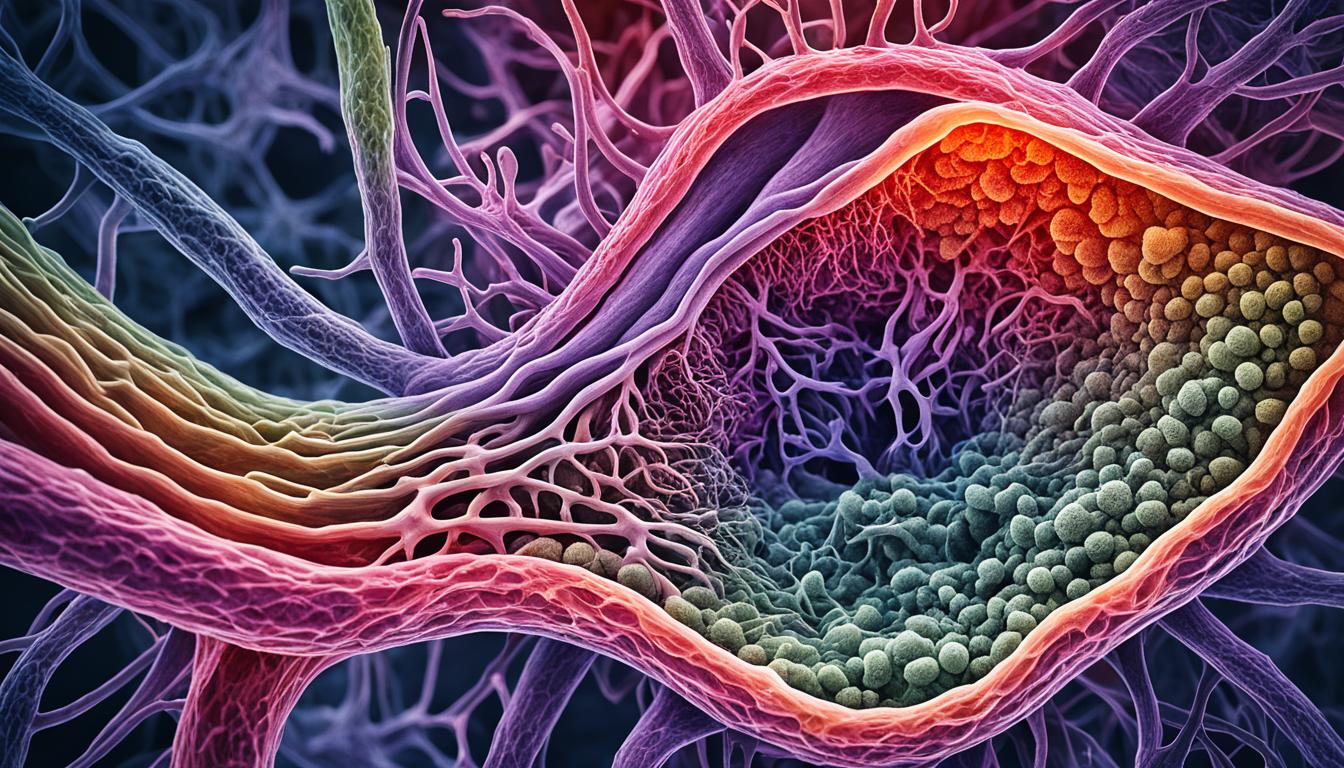Hilar cholangiocarcinoma is a rare cancer. It starts in the biliary epithelial cells. About 15% of liver cancers and 3% of gut cancers are this type. It’s becoming more common worldwide, with a high death rate.
The disease shows through jaundice, belly pain, losing weight, and feeling tired. We don’t know exactly what causes it yet. Risk factors include liver or bile duct diseases, long-term inflammation, and contact with certain toxins and parasites.
Doctors use imaging tests like CT scans and MRIs, plus biopsies, to confirm the cancer. They check how far it’s spread in the body.
Treatments can include surgery, chemo, and radiation. There’s also interest in using stem cell therapy. This new treatment is part of ongoing research in curing various cancers.
Key Takeaways:
- Hilar cholangiocarcinoma is a rare form of cancer that affects the biliary epithelial cells.
- Common symptoms include jaundice, abdominal pain, weight loss, and fatigue.
- Risk factors include primary sclerosing cholangitis, bile duct abnormalities, chronic inflammation, and exposure to certain chemicals and parasites.
- Diagnosis is confirmed through imaging tests and biopsies.
- Treatment options include surgery, chemotherapy, radiation therapy, and ongoing research on the effectiveness of stem cell therapy.
Types and Staging of Hilar Cholangiocarcinoma
Hilar cholangiocarcinoma is a rare cancer type. It splits into two categories: intrahepatic and extrahepatic. The extrahepatic type further divides into perihilar and distal cholangiocarcinoma. The right classification helps pick the right treatment and predict outcomes. The Bismuth-Corlette system is used for perihilar tumors. It helps stage the tumor’s size and guides surgeons before operations.
Staging defines the cancer’s spread and effect. The TNM system considers tumor size, lymph nodes, and spread. The stage affects the chances of recovery. Cancers found early have better paths than late discoveries. Follow-ups are crucial to catch any cancer returns.
Bismuth-Corlette Classification for perihilar cholangiocarcinoma
| Bismuth-Corlette Classification | Bile Duct Involvement |
|---|---|
| Type I | Carcinoma confined to the common hepatic duct |
| Type II | Carcinoma involving the bifurcation of the common hepatic duct |
| Type IIIA | Carcinoma affecting the right or left hepatic duct, but not both |
| Type IIIB | Carcinoma involving both the right and left hepatic ducts |
| Type IV | Carcinoma extending beyond the bifurcation into the right or left hepatic duct and ipsilateral second-order ducts |
Early-stage hilar cholangiocarcinoma often needs surgery. The goal is to remove the tumor and keep the liver working. Later stages might need chemo or radiation to help with symptoms and prolong life. Treatment choices consider the cancer’s reach, patient health, and other illnesses. Deciding on treatment is a team effort between patients and their doctors.
Cholangiocarcinoma research is progressing, offering better ways to diagnose and treat. Trials look into new treatments like targeted therapy and stem cells. By working together, doctors can offer patients with this cancer better chances and a better life.
Advances in Diagnosis and Treatment of Hilar Cholangiocarcinoma
In the last few years, we’ve seen big steps in diagnosing and treating hilar cholangiocarcinoma. Now, imaging tools like CT scans and MRIs give us detailed views. This helps doctors find the cancer earlier and more accurately.
Scientists are also working hard to find biomarkers for this type of cancer. These markers could mean finding and tracking the cancer early. With this, patients might get treatments that match their needs better, which could lead to better results.
When it comes to treating the cancer, we’re looking beyond the usual methods. Targeted therapies and immunotherapies are new ways doctors are fighting cancer. They focus on attacking the cancer, not harming healthy parts.
Stem cell therapy is another exciting area. Studies show it might help fix liver damage. This could really change things for the better for patients.
Right now, there are tests to see how safe and helpful the stem cell therapy is for this cancer. Joining these tests could mean getting top-level care and helping fuel new discoveries. If you have hilar cholangiocarcinoma, talking to your doctor about these options is worth considering.

